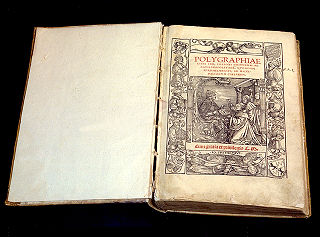Steganography is the practice of representing information within another message or physical object, in such a manner that the presence of the concealed information would not be evident to an unsuspecting person's examination. In computing/electronic contexts, a computer file, message, image, or video is concealed within another file, message, image, or video. The word steganography comes from Greek steganographia, which combines the words steganós, meaning "covered or concealed", and -graphia meaning "writing".
Christian views on magic vary widely among Christian denominations and among individuals. Many Christians actively condemn magic as satanic, holding that it opens the way for demonic possession. Some Christians simply view it as entertainment. Conversely, some branches of esoteric Christianity actively engage in magical practices.

The Index Librorum Prohibitorum was a changing list of publications deemed heretical or contrary to morality by the Sacred Congregation of the Index ; Catholics were forbidden to print or read them, subject to the local bishop. Catholic states could enact laws to adapt or adopt the list and enforce it.

Heinrich Cornelius Agrippa von Nettesheim was a German Renaissance polymath, physician, legal scholar, soldier, knight, theologian, and occult writer. Agrippa's Three Books of Occult Philosophy published in 1533 drew heavily upon Kabbalah, Hermeticism, and Neoplatonism. His book was widely influential among esotericists of the early modern period, and was condemned as heretical by the inquisitor of Cologne.
Thaumaturgy is the practical application of magic to effect change in the physical world. Historically, thaumaturgy has been associated with the manipulation of natural forces, the creation of wonders, and the performance of magical feats through esoteric knowledge and ritual practice. Unlike theurgy, which focuses on invoking divine powers, thaumaturgy is more concerned with utilizing occult principles to achieve specific outcomes, often in a tangible and observable manner. It is sometimes translated into English as wonderworking.
Black magic traditionally refers to the use of magic or supernatural powers for evil and selfish purposes.
The Lesser Key of Solomon, also known by its Latin title Lemegeton Clavicula Salomonis or simply the Lemegeton, is an anonymously authored grimoire on sorcery, mysticism and magic. It was compiled in the mid-17th century, mostly from materials several centuries older. It is divided into five books: the Ars Goetia, Ars Theurgia-Goetia, Ars Paulina, Ars Almadel, and Ars Notoria. It is based on the Testament of Solomon and the ring mentioned within it that he used to seal demons.

Johannes Trithemius, born Johann Heidenberg, was a German Benedictine abbot and a polymath who was active in the German Renaissance as a lexicographer, chronicler, cryptographer, and occultist. He is considered the founder of modern cryptography and steganography, as well as the founder of bibliography and literary studies as branches of knowledge. He had considerable influence on the development of early modern and modern occultism. His students included Heinrich Cornelius Agrippa and Paracelsus.

Books on cryptography have been published sporadically and with variable quality for a long time. This is despite the paradox that secrecy is of the essence in sending confidential messages – see Kerckhoffs' principle.

Henry Spencer Ashbee was a book collector, writer and bibliographer. He is notable for his massive, clandestine three-volume bibliography of erotic literature published under the pseudonym of Pisanus Fraxi.
The Sworn Book of Honorius is a medieval grimoire purportedly written by Honorius of Thebes. The Latin word juratus, which is typically translated "sworn", is intended to mean "oathbound". It's name comes from the alleged compiler Honorius of Thebes, son of Euclid.

The Arbatel De Magia Veterum is a Latin grimoire of Renaissance ceremonial magic published in 1575 in Switzerland.

Renaissance magic was a resurgence in Hermeticism and Neoplatonic varieties of the magical arts which arose along with Renaissance humanism in the 15th and 16th centuries CE. During the Renaissance period, magic and occult practices underwent significant changes that reflected shifts in cultural, intellectual, and religious perspectives. C. S. Lewis, in his work on English literature, highlighted the transformation in how magic was perceived and portrayed. In medieval stories, magic had a fantastical and fairy-like quality, while in the Renaissance, it became more complex and tied to the idea of hidden knowledge that could be explored through books and rituals. This change is evident in the works of authors like Spenser, Marlowe, Chapman, and Shakespeare, who treated magic as a serious and potentially dangerous pursuit.
White magic has traditionally referred to the use of supernatural powers or magic for selfless purposes. Practitioners of white magic have been given titles such as wise men or women, healers, white witches or wizards. Many of these people claimed to have the ability to do such things because of knowledge or power that was passed on to them through hereditary lines, or by some event later in their lives. White magic was practiced through healing, blessing, charms, incantations, prayers, and songs. White magic is the benevolent counterpart of malicious black magic.

Religious censorship is a form of censorship where freedom of expression is controlled or limited using religious authority or on the basis of the teachings of the religion. This form of censorship has a long history and is practiced in many societies and by many religions. Examples include the Edict of Compiègne, the Index Librorum Prohibitorum and the condemnation of Salman Rushdie's novel The Satanic Verses by Iranian leader Ayatollah Ruhollah Khomeini.
Officiorum ac Munerum was an Apostolic Constitution issued by Pope Leo XIII on 25 January 1897. It was a major revision of the Index Librorum Prohibitorum, a list of books prohibited by the Catholic Church. Along with the 18th century Sollicita ac Provida, it forms the Leonine code.
Liber Officiorum Spirituum was a goetic grimoire and a major source for Johann Weyer's Pseudomonarchia Daemonum and the Ars Goetia. The original work has not been located, but some derived texts bearing the title have been found, some in the Sloane manuscripts, some in the Folger Shakespeare Library. Each version bears many similarities to each other and to the Pseudomonarchia Daemonum and the Ars Goetia, though they are far from identical.

Polygraphia is a cryptographic work written by Johannes Trithemius published in 1518 dedicated to the art of steganography.
The history of magic extends from the earliest literate cultures, who relied on charms, divination and spells to interpret and influence the forces of nature. Even societies without written language left crafted artifacts, cave art and monuments that have been interpreted as having magical purpose. Magic and what would later be called science were often practiced together, with the notable examples of astrology and alchemy, before the Scientific Revolution of the late European Renaissance moved to separate science from magic on the basis of repeatable observation. Despite this loss of prestige, the use of magic has continued both in its traditional role, and among modern occultists who seek to adapt it for a scientific world.








